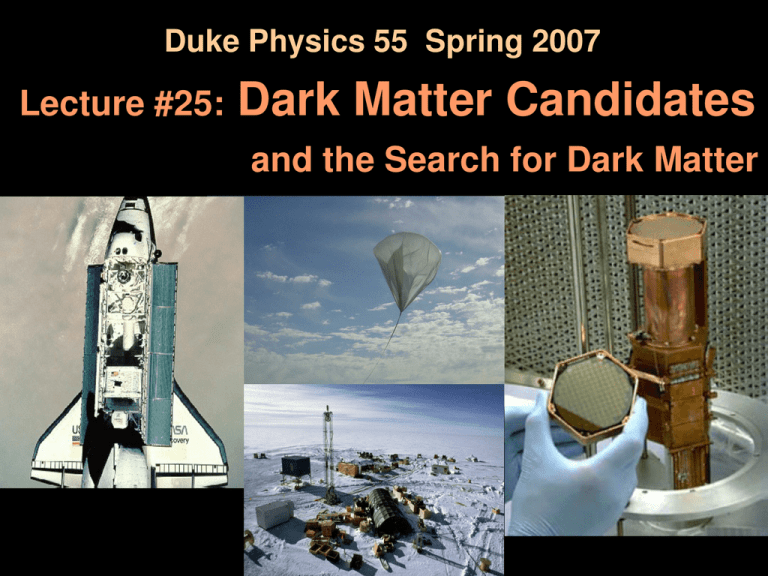DarkMatterCandidates..
advertisement

Duke Physics 55 Spring 2007
Lecture #25: Dark Matter Candidates
and the Search for Dark Matter ADMINISTRATIVE STUFF
­ Quiz 5
­ Homework 10 due
­ Homework 11 available
­ Observing on next week, all groups
(MW: third session; T: second session)
Meet at 7:30 pm; on­or­not at 6 pm
Third session worksheet is available
Please read it carefully; there are changes!
­ pre­observation notes must be handed
in at the beginning of session
­ sketches made during the session must
be handed in
OUTLINE
BDSV Chapter 22.2
Dark Matter Candidates
­ Baryonic Dark Matter
­ MACHOS
­ Non­Baryonic Dark Matter
­ WIMPS
­ Direct and Indirect Detection Techniques
­ Modified Gravity
Review PRS Question
Why do we call dark matter 'dark'?
a. It emits no visible light.
b. We cannot detect the type of radiation that it emits.
c. It emits no or very little radiation of any wavelength.
d. It absorbs the radiation of the stars.
e. It is the reason for the blackness of space.
Why do we call dark matter 'dark'?
a. It emits no visible light.
b. We cannot detect the type of radiation that it emits.
c. It emits no or very little radiation of any wavelength.
d. It absorbs the radiation of the stars.
e. It is the reason for the blackness of space.
The dark matter apparently absorbs
or emits no kind of electromagnetic
radiation (although it does have mass)
Evidence for Dark Matter
Dark matter in galaxies and clusters: various techniques
consistently indicate large amounts of dark matter
Galactic rotation curves
orbital
velocities
of galaxies
within clusters
x­ray
emission
from
intra­cluster
gas
gravitational lensing
Distribution in the Milky Way: gigantic halo
We do have some ideas about the
nature of dark matter...
Could it be ordinary, non­luminous matter?
This is called BARYONIC ('ordinary') DM
[Baryon= proton or neutron; baryons
make up most of the mass of ordinary matter]
Dark matter like us: desks, elephants,
pudding, planets, asteroids...
is only a tiny fraction
of the solar system mass
We assume such ordinary, non­
luminous matter makes up only a small
fraction of the Milky Way, too
... but how do we know? One possibility considered: dark matter in the form of Massive Compact Halo Objects
(MACHOS)
MACHOS
could make up a significant fraction of the Galactic mass? Brown dwarfs (failed stars) or 'Jupiters':
objects with less than 8% of a solar mass never ignite
fusion in their cores
They would be too faint to see, so 'dark'
... but are there enough of them
to make up the dark matter?
Searching for MACHOS
They can be
observed not
by em radiation, but by gravitational MICRO­LENSING
As a MACHO
crosses
a background
star, the star
appears to
brighten, then
dim
Dedicated telescopes scan the stars
of the halo, or nearby galaxy (e.g. LMC)
to look for the distinctive brightening
Microlensing events are rare,
so you need to scan a lot of stars
Some MACHOS are found, but not enough!
MACHOS are at most 20% of the DM
(probably more like 5%)
So, the dark matter is not all MACHOS
In fact we have other reasons (H/He composition of the early universe, leftover microwave radiation... more on that later)
to believe that dark matter is largely
NONBARYONIC
Likely the dark matter is not normal matter at all, but something
entirely exotic and unknown.
It must have mass, and not interact much with
normal stuff
Aside on what we know about normal stuff:
We know of four fundamental forces of nature,
by which particles interact
Strong force: keeps nuclei together
Electromagnetic force:
any charged particle participates; carried by photons
Weak force:
responsible for nuclear decay Gravity:
affects anything with mass
The fundamental matter particles participate in
these interactions
(in fact, their natures are defined by their
masses and their interactions)
Quarks: ­ make up baryons (protons & neutrons)
­ interact via strong, em, weak, gravity
Leptons:
Charged leptons, e.g. electron
­ interact via em, weak, gravity
Neutral leptons: neutrinos
­ interact via weak, gravity
Could the dark matter be neutrinos?
(Neutrinos have mass, and interact weakly)
We think not, because in order
for galaxies to form, dark matter must be COLD: it must be moving slowly
(non­relativistically) Because neutrinos are so light, they are HOT: they are traveling
at nearly the speed of light
According to current understanding,
neutrinos make up only a small portion
of the dark matter
So what else could dark matter be?
Something different from any of the known
particles!
Something MASSIVE (so it would be cold DM)
but which interacts only via the weak interaction
(like neutrinos) would fill the bill
WIMPS: Weakly Interacting Massive Particles
Expect masses ~10's to 100's of times proton mass
As we think now, a much better bet than MACHOS
We would not have already detected such particles,
due to their very weak interactions
Density in our solar system:
about 0.3 proton masses per cc
Typical velocity: same as that of normal
matter in the Galactic halo, few 100 km/s We could be living in a soup of invisible WIMPS
So how can we tell if WIMPS are flying around,
right here and now? Ways of looking for WIMP DM
Direct Detection: look for them here on Earth
Once in a while, they'll bump into
some normal matter
(by the weak
interaction):
look for the
tiny thwack Indirect Detection: look for other evidence
WIMP
Once in a while, WIMPS hit each other and annihilate, spraying out high energy particles: look for these particles
WIMP
Direct DM detection experiments
Look for the rare jostling of ordinary
matter by DM WIMP particles
Very difficult experiments! Must be very low radioactivity,
deep underground, often very cold
(looking for tiny bump, so
must remove thermal vibration)
Cryogenic dark matter direct detection experiments
solid­state
(Si or Ge)
detectors
e.g. CDMS
Soudan mine, Minnesota
Nothing found so far, but next generation
of experiments is improving
Indirect DM detection experiments
WIMP
WIMP
WIMPs will occasionally hit each other
and annihilate... their mass is converted
to lighter particles (of many kinds: electrons
positrons, unstable particles which can
decay to neutrinos, gamma rays, ...)
We may be able to observe the resulting particles
Cosmic ray experiments in space,
or on balloons, attempt to find anomalous energetic particles
(must be above the atmosphere)
Again, so far nothing
found, but experiments
are improving
Another possibility for indirect detection: when WIMPs (occasionally) smack
into things, they lose energy.
They can sometimes become gravitationally
trapped inside large bodies if they no longer have escape velocity
So, you may sometimes have a higher
concentration of WIMPs trapped inside large bodies, e.g. the Sun or the Earth
If there's a higher concentration, they are more
likely to find each other and annihilate
Most products of the annihilation explosion will be absorbed, but some will be high
energy neutrinos, which will get out!
So a way of looking (indirectly) for
evidence of WIMPs is to look for high energy neutrinos coming from the center of the Sun or the Earth!
neutrino detector
The neutrinos occasionally interact
in the Earth, and produce high­energy upward­going particles
We can indirectly search for WIMPS this
way with the Super­K detector
We look for excess neutrino­induced
particles coming up through the detector, from the Sun or Earth center
The larger the detector, the better: very
large neutrino detectors can be made by placing
photon detectors ~meters apart in clear water or ice
Neutrinos are seen
when they create upward
going charged particles, which
make Cherenkov light Example of such a
'neutrino telescope':
AMANDA,
at the South Pole
So far no evidence
for excess of neutrinos from Sun or center
of the Earth due to trapped WIMPS... but...
Bigger and better experiments are under construction
IceCube, a kilometer­cubed experiment
at the South Pole to look for high energy neutrinos
PRS Question
If WIMPs really exist, and make up most
of the dark matter in galaxies, which of the
following is not one of their characteristics?
a. They travel at speeds close to the speed of light.
b. They are subatomic particles.
c. They can neither emit nor absorb light.
d. They tend to orbit at large distances from the
galactic center.
e. All of the above are true.
If WIMPs really exist, and make up most
of the dark matter in galaxies, which of the
following is not one of their characteristics?
a. They travel at speeds close to the speed of light.
b. They are subatomic particles.
c. They can neither emit nor absorb light.
d. They tend to orbit at large distances from the
galactic center.
e. All of the above are true.
Dark matter must be mostly cold (slow­moving)
in order for galaxy formation to occur
Stolen
from web page of Stacy McGaugh, U. of Maryland
You do not know the power of the Dark Side.
Join me, and together we can use dark matter
to make galaxy rotation curves flat!
Some astrophysicists think
that the explanation of the
observations is that gravity is modified at very large distances They may be right, but as yet there is no theory that explains all observations
(note: lensing does not depend on Kepler's third law)
WUN2K
BARYONIC (normal)
dark matter as MACHOS
(Massive Compact
Halo Objects),
e.g. brown dwarfs
­ observed by
gravitational
microlensing ­ make up only a
small fraction of the DM
WUN2K
NON­BARYONIC dark matter: so far best guess is
WIMPS: Weakly Interacting Massive Particles
­ about 0.3 proton masses per cc in
our local neighborhood
­ typical velocity: same as that of normal
matter in the Galactic halo, few 100 km/s
(cold dark matter) WUN2K
Direct Detection: look for tiny thwacks quiet, deep, cold detectors
Indirect Detection: look for other evidence
Once in a while, WIMPS hit WIMP
each other and annihilate, spraying out high energy particles: look for these particles
­ anomalous particles in cosmic rays
­ upward­going neutrino induced particles
from WIMPS trapped in Sun or Earth WIMP
WUN2K
Finally, it could be that gravity is modified at very large distances They may be right, but as yet there is no theory that explains all observations
(note: lensing does not depend on Kepler's third law)
Minute Questionnaire
Please take a minute to fill it out.
I will try to answer as many (well­posed) questions on the web as I can Please use this to give me feedback




